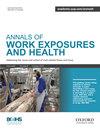311 从研发和工业金属添加剂制造中汲取的经验教训
IF 1.8
4区 医学
Q3 PUBLIC, ENVIRONMENTAL & OCCUPATIONAL HEALTH
引用次数: 0
摘要
金属增材制造(AM),俗称三维打印,是一种新兴的先进技术,具有显著的经济和实用优势。由于其发展历史相对较短,特别是在工业批量生产中,有关接触和健康风险的知识非常有限。为了缓解这一问题,我们在较小的研发基地和大型 AM/粉末生产设施对职业接触和潜在的健康影响进行了监测。通过对总粉尘和可吸入粉尘进行固定采样和个人采样,然后进行金属分析,对接触情况进行监测。使用粒子计数仪器来确定高粉尘工作任务并评估预防措施。AM 操作员和控制人员接受了健康检查,包括问卷调查、肺活量测定、血液和尿液采样,以测量暴露量和临床健康指标。印刷过程中的接触风险一般较低,但生产链的其他方面的接触风险更值得关注:金属粉末原料的生产、印刷前/后金属粉末的处理以及印刷后的处理。在三个研究项目中,我们看到了从粉尘飞扬的工作环境到整个 AM 流程中更安全的设计方法的转变。尽管 AM 操作员接触粉尘和金属的机会相对较少,但我们发现肾功能的尿液标志物发生了变化。不过,这一发现还需要进一步评估。总之,我们对金属 AM 暴露和健康影响这一相对较新领域的研究为帮助处理这些技术的公司和操作人员实现安全工作条件提供了基础。本文章由计算机程序翻译,如有差异,请以英文原文为准。
311 Lessons learned from R&D and industrial metal additive manufacturing
Metal additive manufacturing (AM), commonly known as 3D-printing, is an emerging state-of-the art technology with significant economic and practical advantages. Due to its relative short history, especially in industrial serial production, the knowledge regarding exposure and health risks is severely limited. To alleviate this, we have monitored the occupational exposure and potential health effects at both smaller R&D-sites and at large-scale AM/powder production facilities. Exposure was monitored through stationary and personal sampling of total and inhalable dust followed by metal analysis. Particle counting instruments were used to identify dusty works tasks and to evaluate preventive measures. AM operators and controls underwent health examinations, including questionnaires, spirometry, and blood and urine sampling to measure exposure and clinical health markers. Exposure during printing were generally low but other aspects of the production chain were of greater concern regarding exposure risks: production of metal powder feedstock, handling of metal powder before/after print, and post-printing processes. During three research projects, we have seen a shift from a dusty work environment to a more safe-by-design approach throughout the AM process. Despite the AM operator’s relatively low exposure to dust and metals, we identified changes in a urinary marker for kidney function. However, this finding needs to be further evaluated. In summary, our studies into the relative new field of metal AM exposure and health effects provides a basis to help companies and operators handling these techniques to move toward safe working conditions.
求助全文
通过发布文献求助,成功后即可免费获取论文全文。
去求助
来源期刊

Annals Of Work Exposures and Health
Medicine-Public Health, Environmental and Occupational Health
CiteScore
4.60
自引率
19.20%
发文量
79
期刊介绍:
About the Journal
Annals of Work Exposures and Health is dedicated to presenting advances in exposure science supporting the recognition, quantification, and control of exposures at work, and epidemiological studies on their effects on human health and well-being. A key question we apply to submission is, "Is this paper going to help readers better understand, quantify, and control conditions at work that adversely or positively affect health and well-being?"
We are interested in high quality scientific research addressing:
the quantification of work exposures, including chemical, biological, physical, biomechanical, and psychosocial, and the elements of work organization giving rise to such exposures;
the relationship between these exposures and the acute and chronic health consequences for those exposed and their families and communities;
populations at special risk of work-related exposures including women, under-represented minorities, immigrants, and other vulnerable groups such as temporary, contingent and informal sector workers;
the effectiveness of interventions addressing exposure and risk including production technologies, work process engineering, and personal protective systems;
policies and management approaches to reduce risk and improve health and well-being among workers, their families or communities;
methodologies and mechanisms that underlie the quantification and/or control of exposure and risk.
There is heavy pressure on space in the journal, and the above interests mean that we do not usually publish papers that simply report local conditions without generalizable results. We are also unlikely to publish reports on human health and well-being without information on the work exposure characteristics giving rise to the effects. We particularly welcome contributions from scientists based in, or addressing conditions in, developing economies that fall within the above scope.
 求助内容:
求助内容: 应助结果提醒方式:
应助结果提醒方式:


